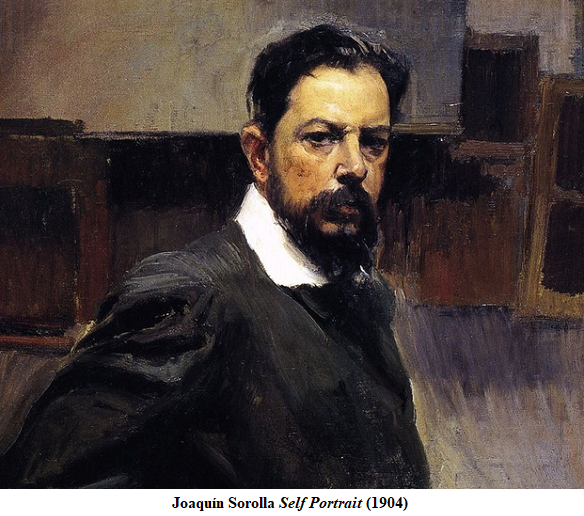
One of the most important retrospective art exhibitions in recent years opened at the National Gallery in London in 2019 and was later shown at the National Gallery in Dublin. Titled Sorolla: Spanish Master of Light, it featured a series of pictures by Joaquin Sorolla y Bastida (1863–1923) who was indisputably Spain’s greatest painter in the period from about 1900 to 1920. This exhibition, curated by Christopher Riopelle of the National Gallery in London, was composed of a large and representative selection of Sorolla’s works drawn from major galleries and private collections. Many of the works travelled from the Museo Sorolla in Madrid, and the painter’s great-granddaughter Blanca Pons-Sorolla gave ready assistance to Riopelle in assembling the exhibition. It was a timely showing, mounted in an epoch when Sorolla’s name was, and arguably still is, not as widely known as it should be, even by persons closely interested in European art.[1]
Sorolla is one of those artists who, for many, was but a name sometimes seen in the glossy yearbooks recording sales at major London auction houses and art dealerships. He and his work thus registered as a Spanish realist painter and portraitist, known particularly for his depictions of scenes of Old Spain, such as oxen hauling fishing boats ashore near Valencia and the like. In the 1960s and 1970s these paintings brought considerable sums at London and Paris, so one at least knew that Sorolla was a name to be reckoned with in the history of art in Spain and Europe.
This essay appears in the latest Quadrant.
Click here to subscribe
Rising from humble origins, Sorolla came to prominence and success in the period preceding that of his countryman Picasso’s bursting forth into international renown, so Sorolla was overshadowed by the Picasso name and fame. Yet, in Spain, he was never neglected and always continued to be honoured after his death. His Madrid home and studio, including his beloved garden, became the Museo Sorolla, and a shrine to him. In 2009, the Prado’s Sorolla Retrospective Exhibition broke attendance records. In 2012, Sorolla’s La Nina Maria Figueroa Vestido de Menina (1901) was included in the exhibition Masterpieces from the Prado at the Queensland Art Gallery.
Various Australian artists of the early twentieth century visited Spain, were impressed with the light and the ambience, and some, notably Lionel Lindsay, with his etchings such as those made of Burgos and other places, executed works in or of Spain.[2] In about 1912, the Australian painter William McInnes, accompanied by William Frater, the Scot who had emigrated to Melbourne, travelled to Spain en route to London and Glasgow. Despite inquiries and researches, I have not yet found any definite information as to whether Lindsay, McInnes or Frater had the occasion to encounter Sorolla in person, although it may be safely surmised they became aware of his work, so esteemed was he in Spain at the time.
One outstanding Australian artist who was definitely aware of Sorolla and who acknowledged Sorolla’s technique and style as a great influence upon him, was Harold Septimus Power (1877–1951) who was born in New Zealand 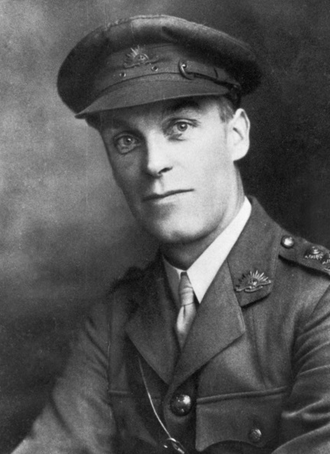 but moved to Australia with his family. He trained in Melbourne in the late 1890s, and painted with Hans Heysen in South Australia between 1900 and 1904. He attended the Academie Julian at Paris from 1905 to 1907 and in 1917, along with George W. Lambert, he was appointed Official War Artist (right) with the Australian Imperial Force in France. His painting of the First Divisional Artillery in Action before Ypres was shown to acclaim in the Royal Academy Exhibition of 1919.
but moved to Australia with his family. He trained in Melbourne in the late 1890s, and painted with Hans Heysen in South Australia between 1900 and 1904. He attended the Academie Julian at Paris from 1905 to 1907 and in 1917, along with George W. Lambert, he was appointed Official War Artist (right) with the Australian Imperial Force in France. His painting of the First Divisional Artillery in Action before Ypres was shown to acclaim in the Royal Academy Exhibition of 1919.
This article firstly notices the signal achievement of Sorolla in his time and as exemplified in his works, which are now much sought after on the international art market, both for their painterly qualities and for the way they record a manner of life in Spain which has long since passed into history, but which at the time when Sorolla was working remained the living tradition of a proud and distinctive people. It then points to the influence of Sorolla upon Harold Septimus Power’s paintings, which exhibit much the same sorts of qualities in their subject matter, the recording of traditional modes of life soon to disappear, and also as to traits of technique, the rendering of light and of high colour. Once upon a time, H.S. Power was an extremely fashionable and wealthy artist, esteemed both in London and back at home in Australia. Indeed, in this he had, albeit on a smaller scale, something like the success of Joaquin Sorolla, who had won major commissions visiting the United States.
Changing views about art, technique and subject matter, particularly after 1945, tended to overshadow or discount the work of artists like H.S. Power, who were then relegated to being known as merely facile depictors of farm, rustic and equine scenes, rather in the way Sir Alfred Munnings was ignored by British critics. Recognition of Power’s ability and merit revived in the 1980s on the Australian art market and, for a period, his works were in demand. At least one Sydney gallerist developed something of a specialisation in Power’s works. Nowadays, one hears less of H.S. Power, but he remains a major Australian artist of very high distinction, and so fully fit to be mentioned alongside Sorolla. This essay recalls the achievement of Sorolla in Spain and the considerable influence of Sorolla on Power in his works of a kindred nature.
JOAQUIN Sorolla, the son of a small trader, was orphaned as an infant, but was adopted by relatives and given early encouragement and a good foundational art education, commencing at the Fine Arts Academy of San Carlo in Valencia. It was perhaps Sorolla’s family background and early adversities which meant that in later life, he remained grounded in the simple things and their depiction, in a world of art that was starting to incline towards abstraction and other experimental departures and doctrines. Sorolla was to adapt his work to include some elements of impressionism on occasion. Yet, although at a certain point he turned away from major prize exhibiting to concentrate on portraits and more intimate and landscape works, he was never tempted to throw his hard-earned technical ability to the winds, nor to adopt that violent reaction to the academy and painterly tradition, as summed up in the cliché “The Shock of the New”, now a tired trope of art history.[3] He studied Velasquez in the Prado at Madrid and after he won some early prizes, in 1884 the City of Valencia awarded him a grant to study in Rome, and he also visited Pedro Gil Moreno de Mora in Paris, where decisively, he saw the major galleries, the Salon for that year, and exhibitions by Jules Bastien-Lepage and Adolf von Menzel. In 1888, his grant was extended and he moved with his wife Clotilde to Assisi in Italy.
After this happy interlude, they returned to Madrid and he began his painting career in earnest, exhibiting nationally and internationally, including at the Paris Salon annually from 1893. These years saw some of his best-known works on social themes, such as The Return from Fishing (1894), And They Still Say Fish Is Expensive (below) (1895) and then a Paris Salon Prize for Sewing the Sail (1897). Sorolla won the Grand Prix at the Paris Universal Exposition in 1900, and then the Medal of Honour at the Madrid National Exhibition in 1901 for his major work Sad Inheritance, a realist work of tragedy and one documenting religious social charity, which would no doubt be misunderstood these days.
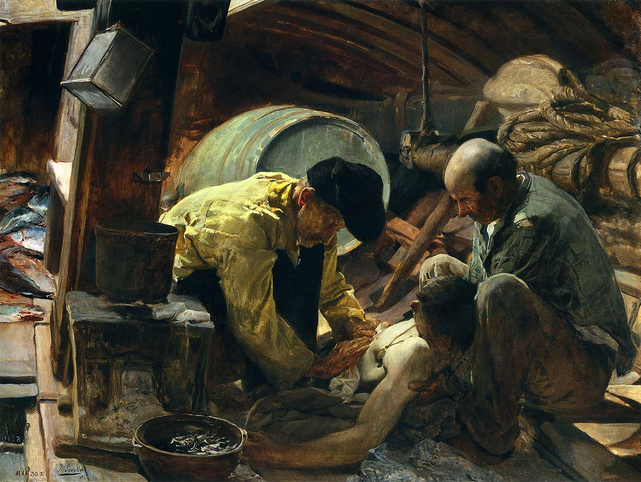
He was also awarded the Cross of the Legion of Honour by the French state, which, given the notorious anti-Catholicism of that time and place, was in itself quite remarkable. In Paris, he met and befriended other major European painters including Sargent, Zorn, Boldini, Kroyer and Carolus-Duran. However, on his return to Madrid afterwards, and despite his successes, he gave up his career as a painter of “official” works for major salons and expositions. Instead, he would now concentrate on a return to the great example of Velasquez and to making a series of portraits of family members which even now remain amongst his finest and best-loved works. These include The Mother (1901) depicting Clotilde and their newborn daughter Elena, which he had earlier commenced in 1895. In 1902 he painted what is one of his masterworks, the superb oil Female Nude, showing the influence of the composition in Velasquez’s The Rokeby Venus, which he travelled to England to see, then still safely in situ up in Yorkshire.[4]
It was with his Afternoon Sun, Beaching the Boat (1903) that Sorolla felt he reached his mature style and achievement as a painter. This large and very impressive canvas, some ten by fifteen feet, takes up a theme drawn from the lives of fisherfolk at Valencia making their precarious living from the sea. He would do various other sea and beach scenes, remarkable for their brilliant use of white paint and also for their use of the oil colour violet in the shadows, the invention of which colour he considered as one of the greatest advances in painting since the time of Velasquez. His beach scenes of mothers and children, rendered in the glistening sunlight, graciously depict a theme later developed cinematically at Venice by Luchino Visconti some sixty years later. They are memorable images and many of them remain at the Museo Sorolla in Madrid, including Strolling along the Seashore (1909) and The Horse’s Bath (1909). Yet they have none of that fin-de-siecle morbidity associated with many works of the French and German schools in the first decade of the twentieth century.
They are works of sunlight, with very little shadow and no feverish overtones. Indeed, some of them are comparable with Max Liebermann’s beach scenes. Sorolla’s oil The Siesta (1911) could remind one of the gentler pictures of some Expressionists, or of works by the Scandinavian painters such as Munch, but totally without that artist’s customary evocations of the element of angst.
Sorolla’s family portraits were, in effect, a portfolio for his many clients who commissioned portraits from him. Some of these are amongst the most engaging portraits of the twentieth century, depicting a variety of well-known Spanish identities in politics, professions, literature and the arts, and aristocrats. Of these the best-known is his portrait of King Alfonso XIII of Spain in Hussar’s Uniform (below), painted in the open air under trees at La Granga in 1907. As with many other major painting outings and occasions, there exists a photograph of Sorolla painting the King, standing with his sabre, wearing the Star of the Order of the Garter and various other orders. It is a work which at once can remind one of Velasquez and also of El Greco’s elongated and swaying forms. Space does not permit mention of more than some high examples of Sorolla’s wonderful portraiture, including that of Jose Echegaray (1905), The Painter Raimundo de Madrazo y Garreta (1906), Antonio Garcia on the Beach (1909), Louis Comfort Tiffany (1911), The Poet Juan Ramon Jiminez (1916) and Gregorio Maranon Posadillo (1920).
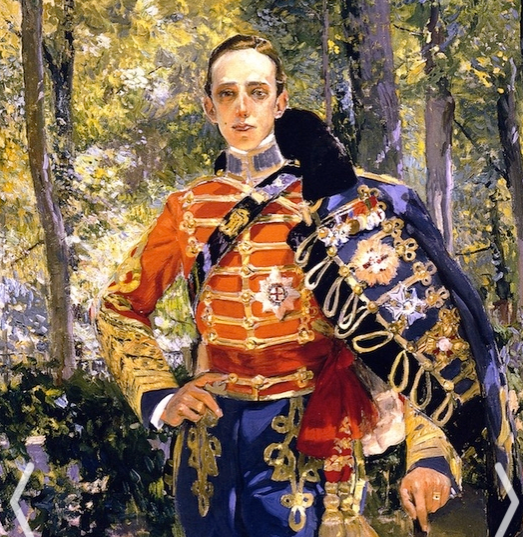
Sorolla’s later major works, akin to his magnificent set of murals Vision of Spain on Spanish traditional life for the Hispanic Society of America in New York, include his Ayamonte, the Tuna Catch (1910). The marvellous sunlight effects, and the rendering of the white uniforms of the group of conversing sailors, just have to be seen to be believed. The New York Vision of Spain is now easily viewed on the internet; as indeed is the fifty-six-minute video Joaquin Sorolla y Bastida: A Collection of 555 Paintings, complete with a superbly evocative and resonant pianoforte background.
Amongst his later works are a series of pictures of roses and other flowers and views in the shaded garden of his house in Madrid, where he had a large studio and a home richly furnished in the Spanish mode with a fine collection of ceramics of the Hispano-Moorish school, which remain in the Museo Sorolla, under a foundation superintended by Blanca Pons-Sorolla.[5]
In addition to works painted on the beaches at Valencia, often with very large canvases secured by elaborate stakes and ropes against the high winds, Sorolla also painted luminous pictures at the Alhambra in Granada and in the Gardens of the Generalife there. His view of the Tower of the Seven Points, Alhambra, Granada (1910) is outstanding in its evocation of the place and unusual in that it discloses a remarkable landscape style, seen in various other works of Sorolla, where a “dry” palette (almost like that favoured by David Bomberg in his views of Jerusalem and in Cuenca at Spain, or of the kind used by Elioth Gruner in Australia), is carried to a very high degree of landscape achievement. There are also some quite late works by Sorolla, apparently done from windows of rooms on upper floors of hotels in Madrid, Valencia or other cities, which are somewhat unusual in his oeuvre, as they feature motor vehicles on the streets. We also have extant many photographs of him working, which show his deep dedication to his art. His bearded appearance in some of the photographs rather resembles that of King George V, or of Sorolla’s contemporary Claude Monet. Sorolla suffered a brain haemorrhage while painting in his garden in 1920 and died in 1923. He received the funeral honours of a field marshal, with representation of the King, of Spain’s military, and the mayor and councillors of the city of Valencia. One could discuss at greater length the many felicities of Sorolla’s work, but it must suffice here to say that his pictures give enormous satisfaction to very many people and he is esteemed as one of the great artists of his period. His influence can be seen in the work of Spaniards like the Catalan Modernist Joaquin Mir Trinxet (1873–1940) and other Colourists.
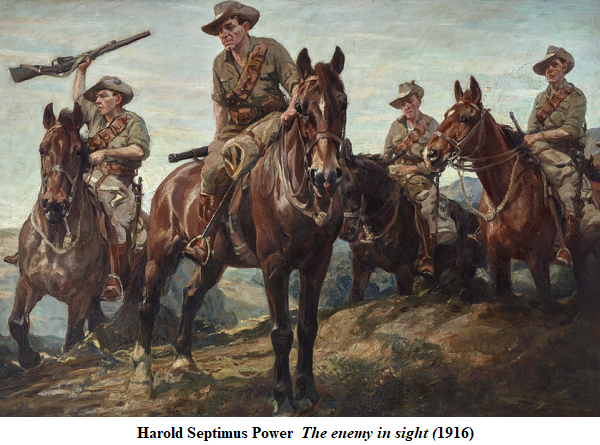
ONE Australian artist influenced by Sorolla’s sunshine was H.S. Power.
Septimus Power was born at Dunedin in 1877, one of the eight children of Peter Power, an English hatter who had come out to Victoria in 1852 at the time of the gold rush at Ballarat. In Melbourne, he married Jane Amers, who came from Edinburgh, and they moved to New Zealand for some years. Arriving back in Melbourne, Peter Power himself did some works as a painter but discouraged his son Septimus from developing his obvious artistic talent. The young H.S. Power duly ran away from home, worked for a carriage painter, and later became involved with the Melbourne Art Club, where he exhibited and won prizes for animal and landscape works. Moving to Adelaide, he worked on illustrations for newspapers and met Hans Heysen, with whom he painted often, and they sold their works through the same dealer.
Power’s big break came when in 1903 the Art Gallery of South Australia commissioned from him an animal painting, After the Day’s Toil, for 100 guineas. The money enabled him to marry and also to travel to Paris, where he studied under the estimable Jean-Paul Laurens between 1905 and 1907, before going to London and associating with the Chelsea artists’ colony. A difficult start was relieved when his major picture Horses at a Fountain was exhibited at the Royal Academy and purchased by the millionaire druggist Sir James Boot. Power became a member of the Royal Institute of Painters in Oils and the Society of Animal Painters as well as continuing also to exhibit at the Royal Academy.[6] Power’s ADB biographer Robert Holden noted, “His first one-man exhibition at the Guild Hall, Melbourne in June 1913 displayed oils and watercolours of rural landscapes, used as backdrops for scenes of equine splendour and hunting, which were to remain popular with both the local and international public and critics for the next thirty years.” His appointment as Official War Artist in 1917 began governmental associations which continued with works for the Australian War Memorial over succeeding decades. In 1927, Power was commissioned to paint the outdoor scene at the opening of Parliament House, whilst W.B. McInnes painted the interior scene.
Holden has pointed out that “Power’s list of international achievements reads as impressively as that of any other contemporary Australian or English artist. He exhibited at the Royal Academy, at the Royal Scottish Academy, the Royal Institute of Painters in Oils, the Royal Society of Portrait Painters, the Royal Watercolour Association and the Paris Old Salon.” These were by no means mere honorifics: association with these various bodies and exhibitions meant very considerable and well-recognised artistic competence and talent. It is rather unfortunate then to read Holden’s overview of H.S. Power’s career and achievements in the following tone and terms:
Apologists for traditional art in Australia between the wars lauded Power’s work for its nostalgic rural vision, reflecting the self-confidence, moral certainties and self-absorption of the Edwardian country-set. Arthur Streeton wrote of his rival’s work, “One is impressed first by a tremendous display of colour and a dauntless feeling of optimism … He displays remarkable knowledge and vigour in his paintings of animals.” Unlike Streeton, Power did not need to re-orient his pictorial emphasis for differing markets in Australia and overseas. In 1934 his only one-man London exhibition was praised for its “healthy orthodoxy of treatment”. At the height of his fame he was seen in a line of artistic descent from Landseer to Munnings. After George Lambert’s death in 1930 Power was the acknowledged leader in Australia of equine subjects. By the mid-1940s however, his technical skill and subject matter were re-evaluated as unfashionable, as empty facility with the brush wasted on sentimental commonplaces and commercialism.
We have seen with Sorolla just how much can be made of “commonplaces” and such criticism is in itself somewhat dated.
It is not necessary for one to be an “apologist” to admire “traditional art in Australia”. The confidence and the pastoral ambience and concerns of much of Power’s work were by no means foreign to, nor even anomalous in, the Australia of his lifetime and especially the major portion of his artistic career. In fact, they really expressed something of what was best in the “old Australia”.
For the truth of the matter is that H.S. Power’s works were indeed vigorous, informed by a magnificent sense of colour and a sure and certain ability and confidence with the brush, which was challenged by few and surpassed by none in Australia after Lambert. Indeed, even Holden gives Power’s mid-career its due:
Between the wars Power lived intermittently in Melbourne and overseas. His departures from and returns to Australia were marked by significant exhibitions, usually featuring a much-praised Royal Academy work as centrepiece. He maintained his selling appeal even through the Depression when prices of five hundred guineas remained not uncommon.
Holden also refers to Power’s major official commissions. It is a curious thing in the modern age, when much of what is exhibited and sold by way of “artwork” is more or less meretricious, that critics charge an artist of Power’s ability and proven skill as a painter, with stooping to “commercialism”.
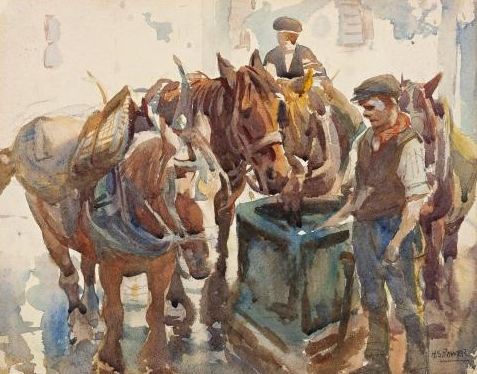
But as Tiepolo famously depicted it long ago, “Time Unveils Truth” and so by 1985, when the Trevor Bussell Gallery in Sydney mounted a major exhibition of H.S. Power’s work, the inevitable re-appraisals were already starting. Indeed, it was Holden himself who wrote a perceptive and fair introduction to this exhibition of some fifty-five works by the artist, encompassing both major oils and notably fine watercolours. Some of these were pictures which are remarkable demonstrations not only of Power’s technical skills in both of those media, but also of his artistic invention and sensibility. Examples worthy of mention include Horses Drinking (1928) (above) and Ploughing (1928), each in oils, both of which could stand alongside the best of Munnings’s work, or indeed of Degas’s equine works. Power’s oil The Macaws (1938) is another work that shows his brilliant colour sense, as well as his fine draftsmanship and composition and his deft brushwork. In fact, they might be in Sorolla’s famous murals at New York. Summertime (1935 AGSA Adelaide) and Goats (1925 Private Collection) are works of great merit, as are examples by H.S. Power in more impressionist mode, such as Jazz Band at the Savoy Hotel London (1926 NGV Melbourne), Naples (1933 Private Collection) and his Paddle Steamer “Ozone” at Dromana (1899). Hence, Holden was able to sum up with this assessment:
Today, over 30 years later [from the 1940s] when Australian sporting art and Australian animal painters have been commanding increasing attention, a reappraisal of H. Septimus Power is long overdue. Unlike Frank Mahony who was born a generation earlier, who made horse painting his forte and who was also part of the expatriate Australian art clique in London before the First World War, H. Septimus Power breached the social and artistic ranks to establish a name lauded by fellow artists and public alike.[7]
One notes the significant omission of critics, some of whom were unfair to Power in his later years. Holden concluded that “certainly a re-evaluation … will prove that Power’s renowned technique and versatility still command respect and attention”.
Works by Power are well represented in the collections of most major public galleries around Australia.[8] This again is indicative of his considerable importance in the history of the art of painting in this country and his merits, which are properly to be considered quite apart from the whims of artistic fashion. Max Middleton, who knew Power very well, noted in The Art of H. Septimus Power (1974) that Power saw many of Joaquin Sorolla’s works when they were exhibited in London. These would have been the 278 works shown at the Grafton Galleries in 1908. Middleton added: “in later years, [Sorolla] was the painter about whom Power spoke most enthusiastically and there is no doubt that the Spaniard left a lasting impression on the Australian”. Indeed, Holden in his work on Lionel Lindsay in Spain implies that some of the works exhibited by H.S. Power in London in the late 1920s were of Spanish subjects.[9]
Given this influence and overall then, there are various parallels to be seen in the lives, careers and artistic achievements of Joaquin Sorolla and H. Septimus Power, both of whom rose to recognised distinction, each in his own country as well as internationally, and enjoyed numerous official commissions. Nor were they merely isolated “national” painters: they fitted into a broadly based movement of post-impressionist painters who never abandoned their solid traditional training and methods. The Finnish painter Wilho Sjostrom (1873–1944) is yet another example of this international movement. Whilst Power is certainly now not as well known worldwide (beyond perhaps, in Britain) as Sorolla became, particularly for his commissioned works in the United States, they are both very good examples of dedicated painters beloved by the public and supported on the art market. They were supreme depictors of certain manners of life which, although passing, yet embodied much of the best in their respective national and cultural traditions. In this lies their outstanding value.
Dr Douglas Hassall, who lives in Melbourne, is a frequent contributor on the arts.
[1] Riopelle C et al Sorolla: Spanish Master of Light Catalogue Essays National Gallery London 2019 passim
[2] Mendelssohn J Lionel Lindsay: An Artist and his Family. Chatto & Windus London 1988 passim; Holden C Lionel Lindsay in Spain: An Antipodean Abroad Melbourne University Press 2003, pp.1-41 and passim.
[3] Dunlop I The Shock of the New: Seven Historic Exhibitions of Modern Art American Heritage Press New York 1972: this book rehearsed the history of major modernist exhibitions between 1863 and 1938, but it also raised the question of whether “tolerance for anything new is a sign of greater sophistication or greater indifference toward artistic merit”. Dunlop was not taken in by the catchcry art-historical trope of “epater les bourgeois”. Even R. Hughes in his book by the same title, ended on a note of doubt and pessimism: The Shock of the New Thames & Hudson 1980 rev ed. 1991 (pp. 365-425 as to the ominous decline seen in the twentieth century).
[4] The Rokeby Venus was very badly slashed by an unrepentant Suffragette at the National Gallery in 1914.
[5] Pons-Sorolla B Sorolla: the Masterworks Rizzoli Electa New York 2012 passim.
[6] Middleton M The Art of H. Septimus Power Rigby Adelaide 1974, passim.
[7] Holden R H. Septimus Power: A Major Retrospective Trevor Bussell Fine Art Gallery Sydney,1985
[8] Power’s works are also in many regional galleries, such as at Ballarat Gallery, Toowoomba TRAG.
[9] Holden C Lionel Lindsay in Spain: An Antipodean Abroad The Miegunyah Press 2003 at page 2.
 Sign In
Sign In 0 Items (
0 Items ( Search
Search










Fascinating reading Douglas and terrific pictures from both but I must say the ones shown by Sorolla really do impact on me the most. The colours in his King Alfonso are startling and the detail plus colour in the Fishing one magnificest to my eyes. I’d love to see his ‘….beaching the boat’ one.
Many many thanks for this, for two reasons:
First, I am a long-term reader of Quadrant for the quality of writing, intellect and eye opening challenges to popular dogma. But it often depresses me. Your article is both beautifully written in the best traditions of Quadrant AND uplifting.
Second, I have been a lifelong fan of impressionism but am glad to have my eyes opened to post-impressionism and several artists I have never heard of. Googling then now to admire their works.
I would love to see more of your art critiques.
thank you for this. Articles like this are what keep me subscribing to Quadrant.